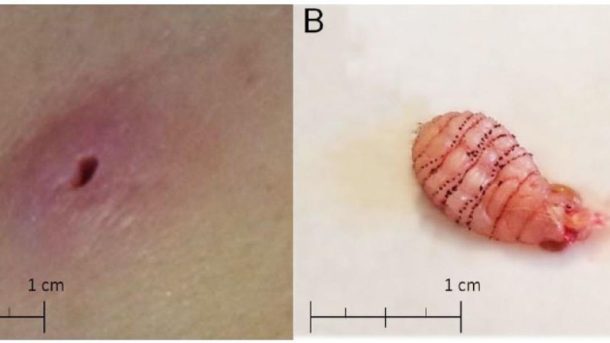A 36-year-old Florida woman discovered that she had a human botfly larva living under her skin following a trip to Belize.
When you come back from your honeymoon, you’ll likely have a souvenir or two—but one Florida woman brought back something she definitely didn’t want to keep: a baby fly that had burrowed into her skin.
The 36-year-old woman (who hasn’t been identified, because, duh), went on her honeymoon in Belize where everything went according to plan—until two months after she arrived back home and noticed something strange, according to a case report published in the Journal of Investigative Medicine High Impact Case Reports.
According to the case report, the woman saw what looked like a pimple on the left side of her groin—the lesion was itchy, but not painful. She assumed she had been bitten by an insect when she was in Belize and saw her doctor, who thought it might be an infected spider bite. She was prescribed antibiotics and sent on her way.
But uh, those antibiotics didn’t do jack, so the woman got a second opinion at a wound management clinic. Doctors there also believed the wound looked like a small bite (by now, the lesion had a hole in the center with pus coming out of it), according to Enrico Camporesi, M.D., lead case report author and a specialist in wound healing at Memorial Hospital in Tampa, Florida, who treated the woman.
But there was something different about the wound: It felt hard to touch (like something was in there), and the woman’s doctors referred her to a surgeon who suspected she had something growing under her skin.
They were right. When the surgeon cut open the wound, they discovered a nasty-looking insect that turned out to be a human botfly larva.
Hold on, a human botfly larva? What is that—and how common are they?
Get ready for this: Human botflies (Dermatobia hominis) are large, densely-haired flies that look like bumblebees, according to the University of Florida—but the larval stage is what you really have to worry about (the adult form of the botfly is rarely seen, per the case report).
When the larvae infect a human host—typically through eggs transferred by a mosquito or fly bite—it’s known as myiasis, and it’s actually the fourth-most common travel-associated skin disease, per the case report. (It’s rarely seen in the U.S., but it’s super-common in residents and visitors of the tropical regions of the Americas.)
Once those eggs are inside the human body, the heat of the skin causes the eggs to hatch into larvae, where it can last anywhere from 27 to 128 days, causing painful pustules that secrete fluid (fun!). That hole that was in the middle of the “pimple”? Yeah, it was so the botfly could breathe.
Botfly larvae are typically found on the genitals, scalp, breasts, and eyes, and, according to the case report, some patients can feel the larvae moving when they shower or cover the wound (cringe).
The (super small) silver lining? Botfly larvae aren’t known to transmit diseases and most cases like this don’t require surgery (patients can usually remove the botfly larvae themselves), per the case report. Left in long enough, the larvae will eventually make its way out of the skin.
But residents in Belize (where botfly larvae are common) have come up with home remedies to get rid of the botfly larvae quicker—including suffocating the larvae by putting petroleum jelly, bacon strips, or nail polish over the wound opening. Still, if the larvae burrow deep enough, they could still require surgical removal.
So yeah, this is freaky–but luckily, the unnamed woman ended up being totally okay. Once the botfly was removed, her skin healed completely, TG.
Human botflies aren’t common in the U.S., but are common among travelers and residents in tropical regions of the Americas.
Fair warning, this video earned a sensitive content alert from YouTube, so keep that in mind as you click play.
Watch the video for more:



